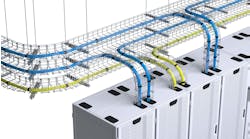It’s Time to Upgrade Data Center Safety
In this week’s Voices of the Industry, Phillip Sandino, Vice President of Data Center Operations at RagingWire Data Centers, examines how data center operators can better protect employees and clients from the hazards of electrical equipment and ensure data center safety.
Phillip Sandino, VP of Data Center Operations, RagingWire Data Centers
For decades, data center technicians have worked on energized equipment, even though they put their lives and others around them at risk.
So why do they keep doing it?
To some extent the answer lies in human nature and the nature of data center operators. As humans, we are creatures of habit. As data center operators we like to follow established procedures.
However, those of us in the data center industry have learned a lot over the past two decades. We’ve changed our engineering, building designs, construction processes, etc. Now it’s time to take a hard look at our operational procedures so we can take steps forward to be a safer industry. It’s time to upgrade our data center safety.
We Need to Stop Doing Energized Work
In a recent roundtable discussion that was hosted by the Uptime Institute, data center industry operators estimated that at least 50% of data centers allow energized work. However, there was not a clear consensus about what exactly qualifies as energized work.
Each data center may define energized work differently, in some cases to meet their own objectives. For example, some data center operators classify energized work as occurring when live equipment is actually touched. At RagingWire, we consider energized work as occurring when a technician even enters a room that has live equipment in it.
If you defined energized work the way RagingWire describes it, the percentage of data centers allowing such work would be much greater than 50%. That means a lot of people are in danger.
Data center operators and contractors should work together
In the top data center markets such as Ashburn, Dallas and Northern California (RagingWire has facilities in all these locations), electrical and mechanical contractors often work at multiple data centers. In order to keep their pipeline of billable time full, they are reluctant to balk or protest at an order that involves working on energized electrical equipment.
Contractors have told us that compared to other data centers, RagingWire is the best in the industry when it comes to prohibiting energized work. We like being the best, but we’d rather see other data center companies joining the drive to upgrade data center safety by eliminating work on energized equipment.
For this dangerous practice to cease, data center operators must step up and prohibit working on energized equipment in no uncertain terms. The culture needs to change.
In addition, data centers should require mandatory, structured training of contractors before allowing them on the data center floor. RagingWire provides an extensive on-site training course for contractors that covers data center access and conduct, work rules, procedures, and policies.
The ROI of Data Center Safety is Compelling
The statistics from arc flash incidents are staggering. Industrial Safety and Hygiene News reported that between 500 and 700 people die every year from arc flash incidents. More than 2,000 people are treated annually in burn centers with arc flash injuries.
The benefits of data center safety are well worth the costs. The average cost of medical treatment from a single arc flash injury is $1.5 million. Typically, injured workers spend 8-12 months away from work, with possibility of permanent disability. The Occupational Safety and Health Administration (OSHA) routinely levies significant fines on companies for not following proper safety guidelines.
Personal protective equipment (PPE) can provide some protection from the electrical shock and burns associated with an arc flash. But the force of an arc blast, which can produce a pressure wave greater than 2,000 pounds per square foot and ear drum-breaking sound waves of 160 dB, can deliver a concussive shock like a bomb went off.
I have heard attorneys say that when injured workers sue for remuneration, in most cases settlements start at seven figures, and go up much higher from there. In fact, the average litigation cost for these incidents is $10 million – $15 million.
NFPA 70E – New Rules for Data Center Safety
The key safety guidelines for data centers come from the National Fire Protection Agency (NFPA). The 2018 version of these guidelines is known as NFPA 70E, titled “Standard for Electrical Safety in the Workplace.” This new edition includes revisions to remove the “prohibited approach boundary,” effectively limiting energized work to only a few applications. Commercial convenience is not one of the exempted activities. OSHA uses NFPA 70E for their safety audits and citations.
So how do we get more data center operators to adopt a culture of data center safety? Here is a checklist of steps to take:
The Path Toward Data Center Electrical Safety:
- Gain commitment from executive leadership to NFPA 70E compliance by:
- Analyzing the potential risks to people and financials
- Consulting with an experienced law firm
- Develop both technical and business practices to work de-energized
- Develop SLAs that clearly show both the company and clients what to expect
- Remember that compliance with the law supersedes contract language
- Develop a legal/business notice of compliance that explains how your company intends to comply with the law
- Build language about exceptions into your policy
- Build compliance into maintenance calendars and methods of procedure (MOPS)
- Analyze your business to understand if you are fully compliant with the law
At RagingWire, the safety of our clients, employees and contractors is absolutely paramount. RagingWire employees who work in client operations, engineering, critical facilities operations, network operating center, and data center security all receive NFPA 70E training. In addition, RagingWire has a Senior Manager of Environmental Health and Safety who ensures that our policies are followed to the letter.
Data Center Safety Matters
We’ve found that the response to our safety initiatives has been almost universally favorable – from employees, contractors and especially clients, who appreciate that they can work in our data centers without being exposed to unnecessary electrical dangers.
Life is precious. There are too many things that we can’t see coming that can bring it to a halt. But we know how arc flashes occur, and how to avoid them. We all want to keep our colleagues safe, so let’s take a step forward together and eliminate energized electrical work in data centers everywhere.
Phillip Sandino is Vice President of Data Center Operations at RagingWire Data Centers, managing end-to-end operations of all RagingWire’s facilities. In addition to critical facilities operations, he has responsibility for corporate safety and security, infrastructure services and commissioning.





